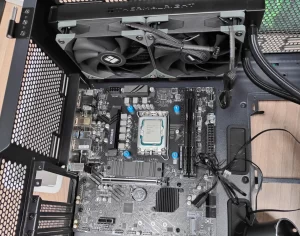CPUs themselves are not “plug and play” in the same way that USB devices or many peripheral components are. When you refer to “plug and play,” you’re typically talking about the ability to connect a device to a computer and have it automatically recognized and set up without needing manual configuration.
However, before using a CPU, many factors must be considered or some preliminary preparations are needed.
How do CPUs Work?

The CPU is like the brain of the computer, handling all the basic operations and instructions. Its work can be boiled down to these steps:
- Fetch Instruction: The CPU grabs the next instruction to be executed from the computer’s memory.
- Decode: The CPU looks at this instruction to decide what needs to be done.
- Execute: The CPU carries out the instruction, which could be actions like addition or storing data.
- Output Results: After completing the calculation or operation, the CPU stores the results, either back in memory or sends it to another part of the computer.
Modern CPUs can process many instructions at once because they have multiple “cores”. Each core can be thought of as a mini CPU.
In simple terms, the CPU constantly pulls instructions from memory, solves the task, and outputs the results.
Is CPUs Plug-and-Play on the Motherboard?
The term ‘CPU plug-and-play’ refers to the simplicity of installation and whether the CPU can function with the motherboard without additional configurations. However, in practice, a CPU is not as plug-and-play as USB devices. It requires considerations regarding compatibility and standardized interfaces.
Physical Compatibility: The most fundamental requirement is that the CPU must fit the motherboard’s socket. For example, an Intel LGA1200 socket CPU will only fit into a motherboard with an LGA1200 socket.
Chipset and Features Compatibility: Even if the CPU fits the socket, the motherboard’s chipset must also support the CPU. Sometimes, a motherboard might physically support a CPU, but you might not get access to all features unless the chipset is compatible.
BIOS/UEFI Compatibility: Some motherboards might need a BIOS/UEFI update to support newer CPUs. For instance, when a new generation of CPUs is launched, older motherboards might need a firmware update to recognize and work with the new chips. This can be a bit tricky because, in some cases, you might need an older, supported CPU to perform the BIOS update before using the new CPU.
If all the above factors align — the CPU fits the socket, the chipset supports the CPU, and the BIOS is updated — then the CPU can be considered “plug-and-play” in the sense that you can install it and expect the system to boot without requiring additional software configurations.
However, the actual process of installing the CPU requires care:
- The CPU must be oriented and seated correctly.
- Thermal paste should be applied appropriately.
- A CPU cooler should be installed to ensure the CPU doesn’t overheat.
You may also like: Do Factory Motherboards Come With Thermal Paste?
Do All CPU Coolers Work On All CPUs?
So, while a CPU can be “plug-and-play” with the right motherboard, the process still requires attention to detail and some knowledge about compatibility and installation.
Do I Need to Install a New CPU without Reinstalling the OS?
When you upgrade or replace a CPU, you typically don’t need to reinstall your operating system (OS). The OS and the majority of software applications are not tightly bound to a specific CPU model. Modern operating systems (such as Windows, macOS, and Linux distributions) can recognize and use various processors without any problems.
However, you need to consider some situations.
- Motherboard and Chipset Compatibility: If you’re just upgrading the CPU and keeping the same motherboard, and the new CPU is compatible with that motherboard, then you likely won’t face any issues. However, if you’re changing the motherboard along with the CPU, you might encounter driver-related challenges, especially with Windows. In some cases, it might be beneficial to do a fresh OS install or at least ensure you have the latest chipset drivers installed.
- Windows Licensing: If you’re using Windows, changing significant hardware components, especially the motherboard, might trigger a reactivation requirement. It’s because the Windows license is often tied to the hardware configuration. If you’re using a retail version of Windows, reactivation should be straightforward. However, if your system came with an OEM version of Windows, you might need to contact the manufacturer or purchase a new license.
- Driver Cleanup: If you’re making a significant change, like moving from an Intel platform to an AMD one, you might want to consider cleaning up old drivers to prevent potential conflicts. Tools like DDU (Display Driver Uninstaller) can be helpful, especially if changing GPU brands, but the CPU change itself shouldn’t pose driver issues.
- Performance Settings: If you had previously adjusted BIOS settings, such as overclocking the old CPU, make sure to reset or adjust these settings appropriately for the new CPU to ensure stability.
FAQs
Is RAM Plug-and-Play?
RAM (Random Access Memory) is generally plug-and-play. This means when you insert compatible RAM into the appropriate slot on a motherboard, the system should recognize and utilize it without requiring manual configuration. However, it’s crucial to ensure the RAM is compatible with your motherboard and is properly seated for optimal performance.
